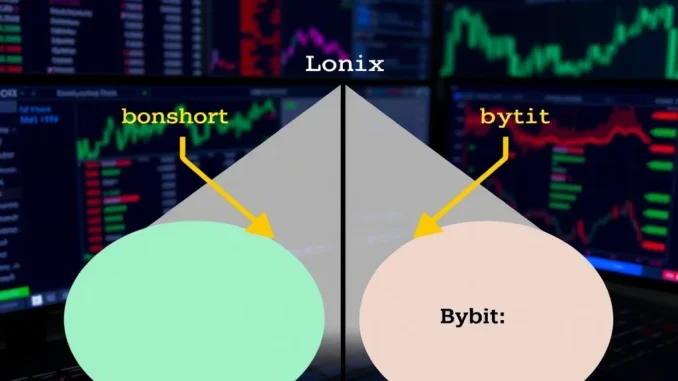
Ever wondered what the smart money is doing in the volatile world of crypto trading? One crucial indicator savvy traders keep a close eye on is the BTC long-short ratio. Think of it as a peek into the collective sentiment of traders betting on Bitcoin’s future price movements. Are they bullish, expecting prices to rise (going long), or bearish, anticipating a dip (going short)? Let’s dive into the latest 24-hour snapshot of these ratios for Bitcoin perpetual futures and see what story the numbers are telling us.
What Exactly is the BTC Long-Short Ratio and Why Should You Care?
In simple terms, the BTC long-short ratio compares the total volume of long positions (bets that Bitcoin’s price will go up) against short positions (bets that Bitcoin’s price will go down) in the perpetual futures market. Why is this important? Because it offers valuable insights into overall trader sentiment and potential market direction. Here’s a quick breakdown:
- Ratio above 50% Long: Generally suggests a bullish sentiment. More traders are betting on Bitcoin’s price to increase.
- Ratio below 50% Long: Generally suggests a bearish sentiment. More traders are positioned for a potential price decrease.
- Extreme Ratios (Significantly above or below 50%): Can sometimes signal potential market reversals or increased volatility. For example, an overwhelmingly long ratio might precede a long squeeze, where excessive long positions are liquidated, causing a price drop.
However, it’s crucial to remember that the long-short ratio is just one piece of the puzzle. It shouldn’t be used in isolation but rather as a supporting indicator alongside other technical and fundamental analysis tools. Think of it as a compass, not a crystal ball. It points towards a possible direction but doesn’t guarantee the exact path.
The Latest Snapshot: 24-Hour Bitcoin Perpetual Futures Long-Short Ratios
Let’s get to the numbers! Here’s a look at the crypto leverage landscape for Bitcoin perpetual futures across various exchanges over the past 24 hours:
Overall Market Sentiment (Across All Tracked Exchanges):
- Long Positions: 50.15%
- Short Positions: 49.85%
At first glance, the overall market appears almost perfectly balanced, with a very slight lean towards long positions. This suggests a neutral to cautiously optimistic sentiment across the aggregated exchanges. But let’s dig deeper and examine the top three exchanges individually.
Breaking Down the Top Exchanges: Binance, OKX, and Bybit
Here’s a closer look at the perpetual futures long-short ratios on three of the leading cryptocurrency exchanges:
| Exchange | Long Positions | Short Positions |
|---|---|---|
| Binance | 49.86% | 50.14% |
| OKX | 50.63% | 49.37% |
| Bybit | 50.10% | 49.90% |

Key Observations:
- Binance: Interestingly, Binance, often the exchange with the highest trading volume, shows a slight bearish bias with short positions marginally outweighing long positions (49.86% Long vs. 50.14% Short). This could indicate that a significant portion of traders on Binance are anticipating a potential short-term price correction.
- OKX: In contrast, OKX exhibits the strongest bullish sentiment among the top three, with long positions at 50.63% and short positions at 49.37%. This suggests a slightly more optimistic outlook on Bitcoin’s price movement on this exchange.
- Bybit: Bybit presents a very balanced picture, almost mirroring the overall market average. The near 50/50 split between long and short positions suggests a high degree of uncertainty or hedging among Bybit traders.
Actionable Insights: How to Use This Data in Your Trading Strategy
So, how can you utilize this Bitcoin futures long-short ratio data to potentially enhance your trading decisions? Here are a few actionable insights:
- Confirmation or Contradiction of Your Analysis: If your technical analysis or fundamental research is pointing towards a bullish Bitcoin move, and you see a consistently increasing long-short ratio, it can act as a confirmation signal, strengthening your conviction. Conversely, if your analysis suggests a bearish trend, but the long-short ratio is heavily skewed towards longs, it might warrant a second look at your analysis or suggest a potential for a long squeeze.
- Identifying Potential Short Squeezes or Long Squeezes: Keep an eye out for extreme deviations in the long-short ratio. A very high long ratio, especially when coupled with other bearish signals (like overbought RSI or negative news), could foreshadow a potential long squeeze. Similarly, an excessively low long ratio might precede a short squeeze.
- Exchange-Specific Sentiment: Notice the differences in sentiment across exchanges. Significant divergence in ratios between exchanges could indicate localized market dynamics or whale activity on specific platforms. However, be cautious as exchange data can sometimes be manipulated or influenced by specific promotions or user demographics.
- Combine with Other Indicators: As mentioned earlier, don’t rely solely on the long-short ratio. Use it in conjunction with other indicators like volume, open interest, funding rates, and price action patterns for a more holistic view of the market.
Conclusion: Staying Informed in the Dynamic Crypto Market
Monitoring the 24-hour long-short ratios for BTC perpetual futures provides a valuable, albeit imperfect, glimpse into the prevailing trader sentiment in the cryptocurrency market. While the current data paints a picture of slight overall bullishness, nuanced differences exist across exchanges. By understanding and incorporating this data into your broader market analysis, you can make more informed trading decisions and navigate the exciting, and often unpredictable, world of crypto trading with greater confidence. Remember to always conduct thorough research and manage your risk effectively!



